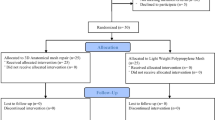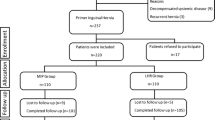Abstract
Inguinal hernia repair is one of the most commonly performed operations in general surgery, with several surgical techniques to do it. The laparoscopic transabdominal preperitoneal (TAPP) approach has gained wide popularity in recent years. Introduction of 3D mesh is one of the recent advances in inguinal hernia treatment. The aim of this study is to evaluate the efficacy of 3D mesh compared to conventional polypropylene mesh in laparoscopic TAPP repair of inguinal hernia. A prospective study was carried out on 60 patients, 30 patients in each group. They underwent laparoscopic TAPP repair of inguinal hernia with 3D mesh or polypropylene mesh over a period of one year. The data analysed included demographic data, mesh spreading time, operative time, post-operative pain, post-operative complications, hospital stay, and chronic groin pain. Follow-up period was 1 year. The mesh spreading time was shorter in 3D mesh 7.32 SD 2.98 vs 12.68 SD 3.59 min, in polypropylene mesh (p = 0.001). The postoperative pain score was higher in polypropylene mesh 4.93 SD 0.87 vs 3.97 SD 0.81 (p = 0.001). The incidence of postoperative complications was not significantly different between the two groups apart from the frequency of chronic pain after 6 months, which was significantly higher in polypropylene mesh group 5 (16.7%) vs 1 (3.3%) (p = 0.02). The non-fixation of 3D mesh in laparoscopic TAPP inguinal hernia repair is a feasible, safe option for surgical treatment of inguinal hernia with shorter mesh spreading time and reduced post-operative pain and chronic pain, without increasing complications nor recurrence rates.

Similar content being viewed by others
References
Kingsnorth A, LeBlanc K (2003) Hernias inguinal and incisional. Lancet 362:1561–1571
O’Riordain DS, Kelly P, Horgan PG et al (1999) Laparoscopic extraperitoneal inguinal hernia repair in the day-care setting. Surg Endosc 13:914–917
Takayama Y, Kaneoka Y, Maeda A, Takahashi T, Uji M (2020) Laparoscopic transabdominal preperitoneal repair versus open mesh plug repair for bilateral primary inguinal hernia. Ann Gastroenterol Surg 4:156–162
Amato B, Moja L, Panico S et al (2012) Shouldice technique versus other open techniques for inguinal hernia repair. Cochrane Database Syst Rev (4):CD001543; update. Cochrane Database Syst Rev 4:CD001543
Ger R, Monroe K, Duvivier R, Mishrick A (1990) Management of indirect inguinal hernias by laparoscopic closure of the neck of the sac. Am J Surg 159:370–373
Fujinaka R, Urade T, Fukuoka E et al (2019) Laparoscopic transabdominal preperitoneal approach for giant inguinal hernias. Asian J Surg 42:414–419
Wauschkuhn CA, Jochen S, Boekeler JS et al (2010) Laparoscopic inguinal hernia repair: gold standard in bilateral hernia repair? Results of more than 2800 patients in comparison to literature. Surg Endosc 24:3026–3030
Tadaki C, Lomelin D, Simorov A et al (2016) Perioperative outcomes and costs of laparoscopic versus open inguinal hernia repair. Hernia 20:399–404
Rashid T, Reshi F, Mir I et al (2018) A comparative study of three-dimensional mesh (3D mesh) and polypropylene mesh in laparoscopic inguinal hernia repairs in adults. Int Surg J 5(1):174–180
Khajanchee Y, Urbach D, Swanstrom L et al (2001) Outcomes of laparoscopic herniorrhaphy without fixation of mesh to the abdominal wall. Surg Endosc 15:1102–1107
Ielpo B, Valentina F, Silva J et al (2020) Laparoscopic transabdominal preperitoneal (TAPP) inguinal hernia repair using fibrin glue for fixation of the mesh and peritoneum closure. Surg Laparosc Endosc Percutan Tech 30(4):e24–e27
Andresen K, Fenger AQ, Burcharth J et al (2017) Mesh fixation methods and chronic pain after transabdominal preperitoneal (TAPP) inguinal hernia surgery: a comparison between fibrin sealant and tacks. Surg Endosc 31:4077–4084
Harsløf S, Krum-Møller P, Sommer T et al (2018) Effect of fixation devices on postoperative pain after laparoscopic ventral hernia repair: a randomized clinical trial of permanent tacks, absorbable tacks, and synthetic glue. Langenbeck's Arch Surg 403:529–537
Bell RC, Price JG (2003) Laparoscopic inguinal hernia repair using an anatomically Contoured Three- Dimensional mesh. Surg Endosc 17(11):1784–1788
The Hernia Surge Group (2018) International guidelines for groin hernia management. Hernia 22:1–165
Van Veenendaal N, Simons M, Hope W et al (2020) HerniaSurge Group. Consensus on international guidelines for management of groin hernias. Surg Endosc 34:2359–2377
Tiwari P, Lankar J, Reddy PK (2016) Contoured 3D mesh in laparoscopic inguinal hernia repair: does it reduce inguinodynia? MOJ Surg 3(4):97–103
Mir IS, Nafae AA, Malyar AA et al (2015) An experience of short-term results of laparoscopic inguinal hernioplasty using 3D mesh in a developing country. International Journal of. Int J Clin Med 6(01):64–69
Tantia O, Jain M, Khanna S, Sen B (2009) Laparoscopic repair of recurrent groin hernia: results of a prospective study. Surg Endosc 23:734–738
Bangash A, Khan N, Sadiq M (2012) Composite polypropylene mesh versus lightweight polypropylene mesh: The TAPP repair for laparoscopic inguinal hernia repair. J Sci Soc 39:64–69
Bagul A, Narwade N, Mota P et al (2019) Comparative efficacy between open 3d mesh and conventional mesh in patients of inguinal hernia. Int J Surg 3(1):09–11
Bowne WB, Morgenthal CB, Castro AE et al (2007) The role of endoscopic extraperitoneal herniorrhaphy: where do we stand in 2005? Surg Endosc 21(5):707–712
Brescia A, Tomassini F, Berardi G et al (2017) A new fixation-free 3D multilamellar preperitoneal implant for open inguinal hernia repair. Can J Surg 60(1):66–68
Chalkoo M, Mir MA, Makhdoomi H (2016) Laparoscopic transabdominal preperitoneal mesh hernioplasty: a medical college experience. Surg Sci 7(02):107–113
Prakash P, Bansal VK, Misra MC et al (2016) A prospective randomised controlled trial comparing chronic groin pain and quality of life in lightweight versus heavyweight polypropylene mesh in laparoscopic inguinal hernia repair. J Minim Access Surg 12(2):154–161
Author information
Authors and Affiliations
Contributions
All authors contributed to the study conception and design. Material preparation, data collection, and analysis were performed by Hosam Elghadban, Ahmed Negm, Islam Hisham, and Ahmed Taki-Eldin. The first draft of the manuscript was written by Ahmed Taki-Eldin, and all authors commented on previous versions of the manuscript. All authors read and approved the final manuscript.
Corresponding author
Ethics declarations
Competing Interests
The authors declare no competing interests.
Additional information
Publisher’s Note
Springer Nature remains neutral with regard to jurisdictional claims in published maps and institutional affiliations.
Rights and permissions
Springer Nature or its licensor (e.g. a society or other partner) holds exclusive rights to this article under a publishing agreement with the author(s) or other rightsholder(s); author self-archiving of the accepted manuscript version of this article is solely governed by the terms of such publishing agreement and applicable law.
About this article
Cite this article
Elghadban, H., Negm, A., Hisham, I. et al. Fixation of Conventional Polypropylene Mesh Versus Non-fixation of 3D Mesh in Laparoscopic Transabdominal Preperitoneal (TAPP) Inguinal Hernia Repair: a Randomized Controlled Trial. Indian J Surg (2023). https://doi.org/10.1007/s12262-023-03974-y
Received:
Accepted:
Published:
DOI: https://doi.org/10.1007/s12262-023-03974-y




